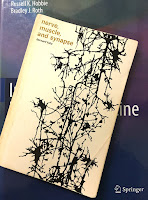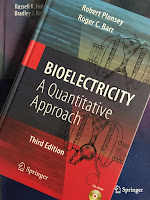 |
| Suki Roth, in front of a copy of Intermediate Physics for Medicine and Biology. |
I think my hearing is getting worse too, but slowly. My dad uses a hearing aid, and I take after him. I find myself asking “what did you say?” more often than other people do. I decided to test myself using the website http://www.animations.physics.unsw.edu.au/jw/hearing.html. Below I plot my hearing (red dots) as a function of frequency, and compare it with the normal hearing response of a young adult (solid curve) shown in Figure 13.7 of Intermediate Physics for Medicine and Biology. I normalized the two curves so they are equal at 1 kHz.
 |
| My hearing response curve. |
I didn’t follow the website’s instructions exactly. I plotted the lowest intensity tone that I could just hear. I don’t trust this test, performed on myself using a website; it is very subjective and the loudness changes in large 3 dB steps. (In case you do not have IPMB handy, Eq. 13.34 indicates that a ten-fold change in intensity corresponds to a step of 10 in decibels.) I would be interested in hearing (get it?....) if you have a similar result using this website.
Age-related hearing loss is called presbycusis. Wikipedia says it is the second most common illness in the elderly, after arthritis. Normally we lose the high frequencies as we age, which has implications for how teenagers choose ringtones.
On the above video, I could hear the 8 kHz ringtone but not the 12 kHz or higher ones. Can you? I am not sure if it is me, my computer, or the video.
I may be losing some hearing, but probably not much. (Perhaps I just don’t pay attention when my wife talks to me.) Suki, however, is in worse shape. She is the world’s best pet, and I intend to give her extra treats to make up for her lack of hearing.





